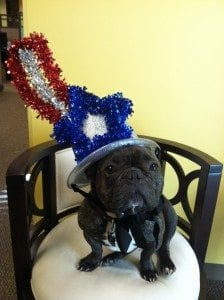Independence Day is lots of fun for you – you can celebrate your independence with bright fireworks, a party with friends, parades, and ice cream and beer. However, the fourth of July might not be such a pleasure for your dog, who can be harmed or even killed by the very things you love the day for. Some dogs are terrified by fireworks, some might sneak a drink of that beer, and others can be frightened by crowds and the noise and sight of parades. Be aware that at this time of year Fireworks are inevitable. Dogs will try and find recluse which may mean away from your house, yard, etc. Pay attention to their reactions and remember that dogs don’t mind being crated during loud noises. It makes them feel secure.
1. Ensure that your pet’s information is up to date. Many dogs escape when they are startled by fireworks. If your pet doesn’t have a collar with a tag that has contact information on it, as well as a microchip with your current information, now is the time to get them.
Your collar should fit securely but comfortably; it should be snug enough that it won’t be easily caught on a branch or other other such thing, but not so tight as to make it uncomfortable for your dog to wear it. Be certain that it doesn’t restrict your dog’s air flow – you should be able to fit two fingers between your dog’s collar and neck. There should be a tag that ensures the dog does not have rabies and another with your name and phone number on it.
A microchip is a tiny transponder that uses radio frequency waves to transmit information on the chip about your pet when scanned. It is implemented painlessly just under the skin using a large-bore needle by veterinarians and some shelters. Once your dog has a microchip, you must register with the company the microchip is made by; now, if your dog arrives at a shelter, (s)he will be scanned and the microchip will give the shelter your phone number to contact you with. Your microchip must have recent contact information; if it does not, simply contact the microchip company to update your information.
2. Brush up on your dog’s training. Your dog should have basic obedience training, and should easily respond to you. The most vital commands to train are walking on leash, “come,” and “leave it,” in addition to crate training.
If your puppy is young and hasn’t been leash trained, and you intend to bring the dog to parades/parties/fireworks displays, now is the time to do this.
Your recall command should be rock-solid. If your dog runs off in reaction to fireworks, or after an interesting smell, you must be able to recall him.[3] A related command is “stay”
During parties or parades, your dog is likely to come across yummy food that’s unhealthy for him to eat. To prevent him from eating anything he shouldn’t, your “leave it” command should be very good. Another useful, related command is “drop it.”
A crate is a useful tool during 4th of July celebrations, serving both to safely contain the dog and often calm him/her.
3. Plan your party carefully. Choose decorations carefully – glow sticks, which are both toxic for dogs and enticingly similar to colorful chew toys, are particularly dangerous. As beer and other people food and drink are toxic for dogs, decide on a place to keep your dog(s) during the party, such as in the house if the party is in the yard. If the dog is friendly and would like to stay with the people, consider keeping him with you leashed; contained by keeping him in a room with a baby gate barring passage if the party is inside; or securely tying him to a tree, fence, or other secure object if the party is outside.
Before the party, research what foods are toxic to dogs.
4. Contact a veterinarian. For owners of dogs that are extremely reactive to fireworks or other typical Independence Day activities, the best option may be to discuss ways to help your dog with an experienced veterinarian. Topics to discuss include reducing stress for older dogs and the option of sedating the dog using safe drugs.
Information provided by: WikiHow




